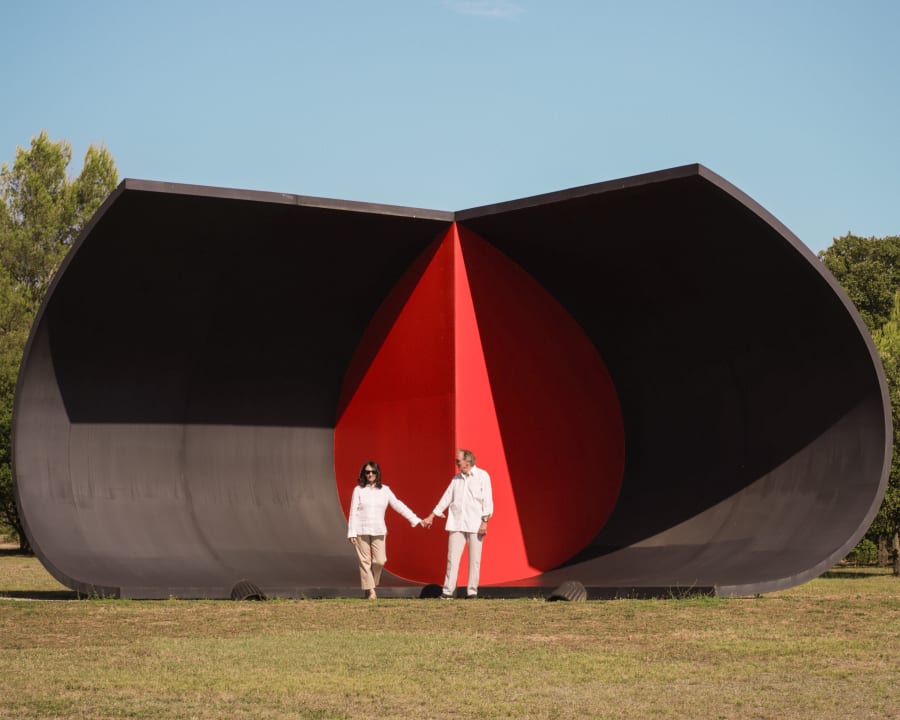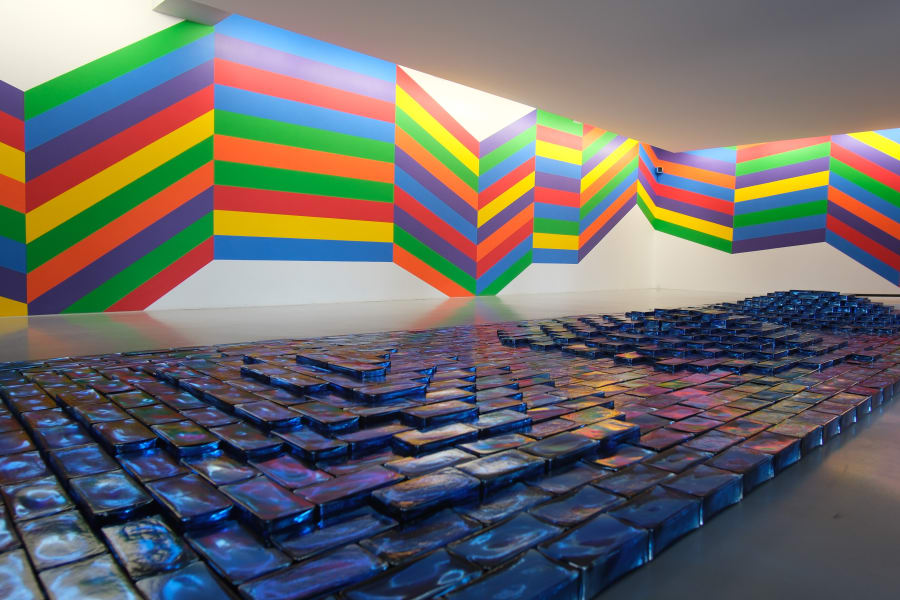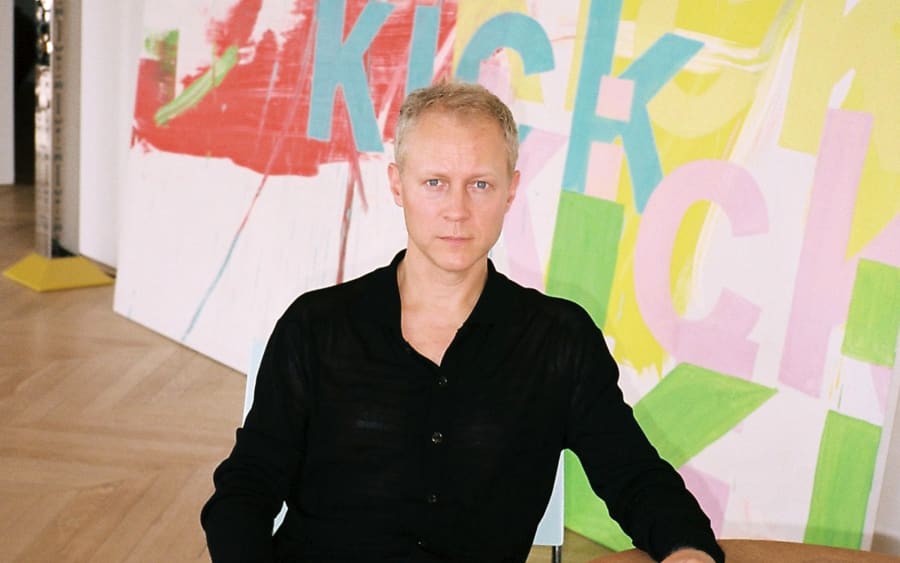In the courtyard hangs a double swing, looking like a brain split into two lobes. Designed by Didier Faustino for Josée and Marc Gensollen as a place for dialogue, it serves as a metaphor for their passion. Over more than 50 years, the Marseille-based psychiatrist couple has built one of the most unique collections of Conceptual art in France. And they’ve never stopped sharing it with others. In their ‘Fabrique’ – a former spinning mill they converted two decades ago into a home – they’ve meticulously installed some 800 works. Not a single corner of the space is left untouched. In the dining room, light fixtures by Liam Gillick are pierced with phrases referencing a ‘“Ballad of the hanged” in old Welsh,’ they explain with a glint of provocation. The chairs? They’re by Franz West, colored by Heimo Zobernig. Everywhere there are works by artists they spotted early on: Pierre Huyghe, Philippe Parreno, Rirkrit Tiravanija, Maurizio Cattelan. The latter’s A Love Without Words (1998), a fur-covered baby in a papal mitre, crawls across the floor, while in Cattelan’s The 1:6 Scale Wrong Gallery (2005), ‘the kids hide their Smurfs,’ Josée jokes.
For all their exhibition catalogues, they’ve built an enormous library. For themselves, a monastic bedroom. In 2008, they acquired the neighboring property to create an artist residency under the shade of eucalyptus and banana trees. ‘To buy it, we sold a Basquiat we had purchased around 1982 to introduce our kids to the art of their time,’ they explain. It remains the only work they’ve ever let go. On the roof, a sculpture by Jean-Luc Moulène sets the tone already from the street: three interlocked Borromean rings – a nod to Jacques Lacan, the psychiatrist whose teachings guide them still. ‘Marc spent an entire morning chiseling off a mosaic placed just underneath by Invader,’ Josée recalls. ‘It distorted the meaning completely,’ Marc adds.
In conversation they complete each other’s sentences, correct one another, and sometimes cut across each other. Talking, for them, is a lifelong practice – and a form of art. After decades of 14-hour workdays devoted to their patients, they’re now retired, wholly committed to their collection. For them, buying together has always been the only way. ‘We listen to one another – 95% of our acquisitions are by mutual agreement. Though Josée can be a little emotional,’ Marc notes. ‘Now,’ Josée counters, ‘I travel more. Marc is quite involved with the Académie des Sciences, Lettres et Arts de Marseille, where he holds a seat dedicated to contemporary art. He has a bit less time for discovering artists I’d like to introduce him to. And he’s very critical.’ ‘Not critical,’ he retorts, ‘exacting.’
Communication has always been the through-line of their rigorously Conceptual collection. ‘We started out in 1968 – a year of protest. Our training also taught us to question everything. And we’ve always believed in one ideal: art as idea. This tripartite focus shaped us,’ Marc reflects. Both self-taught when it comes to art, they began collecting in 1972. Their first purchase: ‘A drawing by a Surrealist – worth five times our income as med students. It opened a window onto the intrapsychic.’ They were guided early on by artist friends like Stanley Brouwn, Lawrence Weiner, Jimmie Durham, and Antoni Muntadas. ‘And Daniel Buren, of course – uncompromising faced with mediocrity, but who speaks so beautifully about art .’ They’re equally grateful to the gallerists who talked about art without trying to always sell them something: Michel Durand-Dessert, Marian Goodman, Konrad Fischer, Chantal Crousel…or Victor Gisler, founder of Mai 36 Galerie. ‘He was wonderfully patient – we tormented him for two or three years before really connecting with Matt Mullican’s work. Today we own many pieces.’
They’ve never tired of roaming art fairs and gallery shows. Last June marked their 43rd visit to Art Basel, which they first discovered in 1981, ‘when it still felt very provincial. We’ve since watched it gain prominence, and it remains a key moment for us – even if the market has now priced us out in relation to many of the artists we love. Still, the fair’s frenzied energy pushes us to keep discovering.’ Among their latest finds: Oriol Vilanova, chosen to represent Spain at the upcoming Venice Biennale. ‘He asked us to write a love letter to our collection. We also have a sealed mailbox from him, filled with 243 postcards scavenged from New York. We pledged never to open it. Artists are getting more and more sadistic with us,’ Marc laughs.
Trends and the market mean little to them. ‘We seek what feels universal – On Kawara, who reduces us to the infinitesimal; Roman Opałka and his relationship with time; Gabriel Orozco’s Piedra que cede [1992], which records its path through its changing form.’ They’ve never strayed from their guiding principle: ‘We seek intellectual, not retinal, pleasure.’ They find it in Christian Boltanski's first ‘Monument’; in Gianni Motti’s solar eclipses; in Saâdane Afif’s The Slave (2005), a yucca that keeps growing despite its chains. Mario García Torres’s Title Working (2005 ), a piece that exists only through verbal description, delights them. As does Dan Graham’s dual-channel video installation, ‘which is about being seen, seeing yourself, and seeing yourself being seen.’ They’ve just installed it at home for the first time after years of lending it. ‘Along with Bruce Nauman, Dan Graham allowed us to reintroduce the body into a collection that had become almost too cerebral,’ Josée concedes. Now, they’re thrilled to offer guests this disarming voyeuristic experience. ‘There’s nothing we love more than demystifying art that’s considered opaque, bringing it to life.’ Often quite literally: their collection has been lent to 140 museums. But more than anything, they share it with artists, collectors, curators – in this ‘meeting house’ that is much more than a place of pleasure.
Speaking with visiting high school students, they trace Conceptual art’s lineage – Marcel Duchamp, Kazimir Malevich, Renaissance codes. And they get just as much from high-level debate with seasoned enthusiasts. One of their most revered works is a simple chalk circle by Ian Wilson, who made oral communication his medium. ‘The piece exists in the thickness of the line, but mostly in the conversation it sparks.’ They’re equally enthralled by Wilson’s spiritual heir, Tino Sehgal, ‘whose work is also passed on orally and leaves no physical trace.’ Recently, Sehgal came to Marseille to teach them a dance from a performance they’ve acquired. They sometimes perform it – ‘if the audience is ready to receive it.’ Just like they activated Roman Ondak’s work with each of their grandchildren: teaching a baby to walk in an art space. ‘A performance full of promise – rooted in the present and open to the future.’ On one of La Fabrique’s walls, a phrase by Navid Nuur sums up their philosophy: ‘Vision needs no eyes to see.’
Emmanuelle Lequeux is a journalist based in Paris.
English translation: Art Basel.
Caption for header image: Josée and Marc Gensollen, 2025. Photograph by Baptiste de Ville d'Avray for Art Basel.
Published on August 27, 2025.


